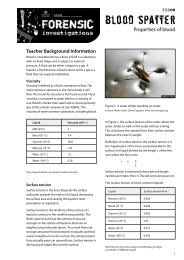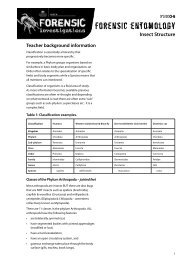FSP 19 Anthropometry [PDF File, 298.3 KB]
FSP 19 Anthropometry [PDF File, 298.3 KB]
FSP 19 Anthropometry [PDF File, 298.3 KB]
You also want an ePaper? Increase the reach of your titles
YUMPU automatically turns print PDFs into web optimized ePapers that Google loves.
<strong>FSP</strong><strong>19</strong>Anth ro po m etryTeacher activity informationThe Student Handouts that relate to these activitiesare found in <strong>FSP</strong>25 – Personal Dossier underthe section <strong>Anthropometry</strong> Table.What are anthropometric measurements? They aresimply body dimensions.The main thing about making anthropometricmeasurements is that the students must beconsistent. This means that if a student measuresPerson X on Monday and then takes the samemeasurements from Person X on Tuesday (under thesame conditions) they will get a very similar result.They must also be accurate. This means that if astudent measures Person X on Monday, and anotherstudent also measures Person X on Monday, theywould both get very similar results.To do this the students MUST follow a procedure soeveryone is taking the measurements the same way.See below.Equipment• Tape measure (the Lufkin tapes are the best asthey have even pressure and don’t stretch).• 1 meter ruler.• 30 centimeter ruler.• Marking chalk - a make-up eyebrowpencil is good – students can mark thesites to measure from (optional).• Pen and worksheet to record results(<strong>FSP</strong>25 <strong>Anthropometry</strong> Table handout).• Height chart – attached to a wall (pre-prepared).• Arm span chart attached to a wall (pre-prepared).MethodThe students should work in groups of 3 all taking aturn at the 3 roles:• Subject – the person being measured.• Anthropometrist (measurer) – the person doing themeasuring• Recorder – the person writing down themeasurements.When a student is the anthropometrist, they shouldcomplete all of the measurements in the order thatis on the worksheet. When they have taken themeasurement, they call out to the recorder, whothen repeats what was said and writes it down.For example, the anthropometrist says, “twenty twopoint zero centimetres”, and the recorder repeats,“twenty two point zero centimetres” and writes itdown on the subject’s worksheet.After the anthropometrist has completed one roundof all of the measurements, they repeat them allagain from the beginning.The recorders do NOT tell the anthropometrist iftheir second measurement is close or far apart fromtheir first measurement.If the second measurement is a lot different (1cmor greater difference) than the first measurement,the anthropometrist should do a third measureafter they have completed the second round ofmeasurements.
<strong>FSP</strong><strong>19</strong>Anth ro po m etryTeacher activity informationAverage of the measurementsWork out the average measurement by adding Measure 1and Measure 2 and dividing by two.If you have taken three measurements, you DO NOTaverage the three measurements but add together the twoclosest measurements and divide by two.Eg: length lower arm:Measure 1 =20cm, Measure 2 =<strong>19</strong>cm, Measure 3 =<strong>19</strong>.5cm.Add <strong>19</strong> + <strong>19</strong>.5 and divide by 2.Average length = <strong>19</strong>.25cm.Measurement TechniquesIn the Personal Dossier, students are asked to decideon a uniform and consistent method taking ALL of themeasures.The techniques below are a guide as to what is acceptable.NB: These are NOT techniques as accredited by ISAK but aremodified for this activity. The most important thing is thatALL students take the measurements the same way.Anthropometric measuresStanding heightA chart with accurately marked intervals ora tape needs to be secured to the wall.Arm spanIt is useful to use a corner of the room soonly one mark needs to be made.Length lower armElbow to wristLength lower legKnee to ankleLength of footHeel to longest toeCircumference of headSuggested TechniqueFeet together, heels, buttocks and upper part of back touchingthe wall. The head should not tilt upwards – check that thesubject is looking straight ahead (chin slightly tucked in).The subject should breathe in, (keep heels on ground).The measurer places a ruler at on the top of the head with firmpressure and holds the ruler in place as the subject slips out fromtheir position. The measurer reads the score to the recorder.The subject stands with the back to the wall with the armsas horizontal as possible, palms facing forward, fingers fullyextended. Measure from tip to tip of the third fingers.The measurement should be taken from the upper edge of theelbow bone to the wrist bone on the thumb side of the hand.Subject should be seated, with their right ankle resting ontheir left knee. Measure from the fold of skin at the creaseof the upper leg and lower leg and the ankle bone.This should be the distance from the longest toe to the mostposterior point on the heel of the foot while the subjectis standing with their weight evenly distributed.Tape should be just above the eyebrows, above theears and pulled fairly tight to compress the hair.
<strong>FSP</strong><strong>19</strong>Anth ro po m etryTeacher activity informationMaking the measurement chartsHeightA piece of paper with 0.5cm intervals marked can betaped to the wall.Rather than writing in all the intervals, determinethe general range of heights within the class andcomplete a 30 to 40cm wall chart.Arm spanThe arm span measurement will be similar to theheight of the students. Create an interval chart andattach to the wall 1 meter from a corner.Students will stand with their fingertip of the thirdfinger on the wall.


![FSP 19 Anthropometry [PDF File, 298.3 KB]](https://img.yumpu.com/51210323/1/500x640/fsp-19-anthropometry-pdf-file-2983-kb.jpg)


![FSE 09 Case studies [PDF File, 140.2 KB] - Centre for Learning ...](https://img.yumpu.com/48750159/1/184x260/fse-09-case-studies-pdf-file-1402-kb-centre-for-learning-.jpg?quality=85)
![FSE 03 [PDF File, 125.2 KB] - The University of Western Australia](https://img.yumpu.com/47991868/1/184x260/fse-03-pdf-file-1252-kb-the-university-of-western-australia.jpg?quality=85)
![FSE 01 Overview [PDF File, 163.0 KB]](https://img.yumpu.com/47583056/1/184x260/fse-01-overview-pdf-file-1630-kb.jpg?quality=85)
![FSE 10 Teachers activity [PDF File, 3.0 MB] - Centre for Learning ...](https://img.yumpu.com/45506425/1/184x260/fse-10-teachers-activity-pdf-file-30-mb-centre-for-learning-.jpg?quality=85)

![Chapter 03 [PDF File, 468.5 KB] - Centre for Learning Technology](https://img.yumpu.com/44881443/1/184x260/chapter-03-pdf-file-4685-kb-centre-for-learning-technology.jpg?quality=85)
![Chapter 09 5 [PDF File, 192.4 KB]](https://img.yumpu.com/44599682/1/184x260/chapter-09-5-pdf-file-1924-kb.jpg?quality=85)
![FSB 03 [PDF File, 151.9 KB]](https://img.yumpu.com/43260078/1/184x260/fsb-03-pdf-file-1519-kb.jpg?quality=85)

![FSE 11 Rearing flies [PDF File, 388.4 KB]](https://img.yumpu.com/41885287/1/184x260/fse-11-rearing-flies-pdf-file-3884-kb.jpg?quality=85)
![FSP 26 Crime Dossier [PDF File, 3.2 MB]](https://img.yumpu.com/36466452/1/184x260/fsp-26-crime-dossier-pdf-file-32-mb.jpg?quality=85)
![FSE 07 Forensic entomology [PDF File, 196.9 KB]](https://img.yumpu.com/35416705/1/184x260/fse-07-forensic-entomology-pdf-file-1969-kb.jpg?quality=85)